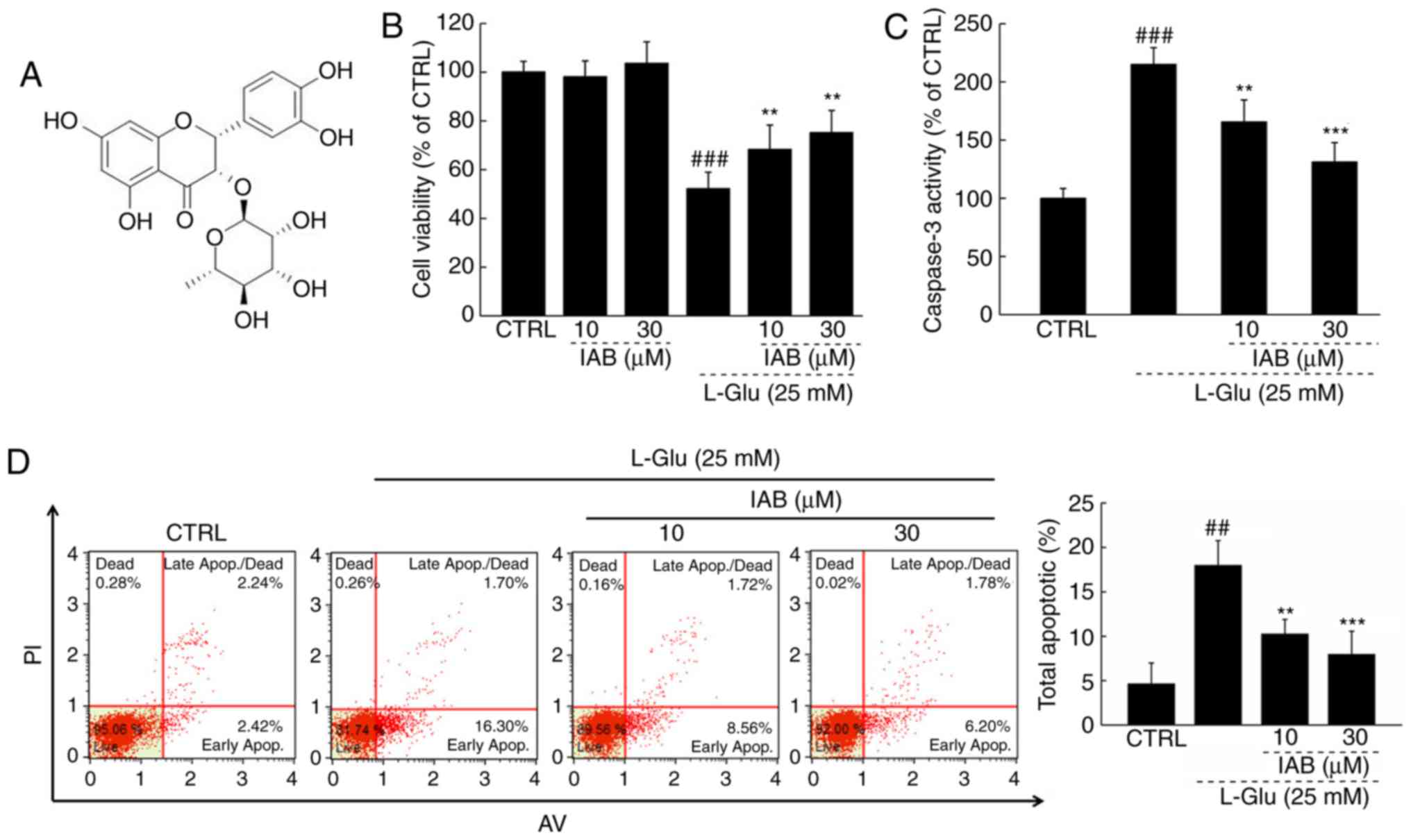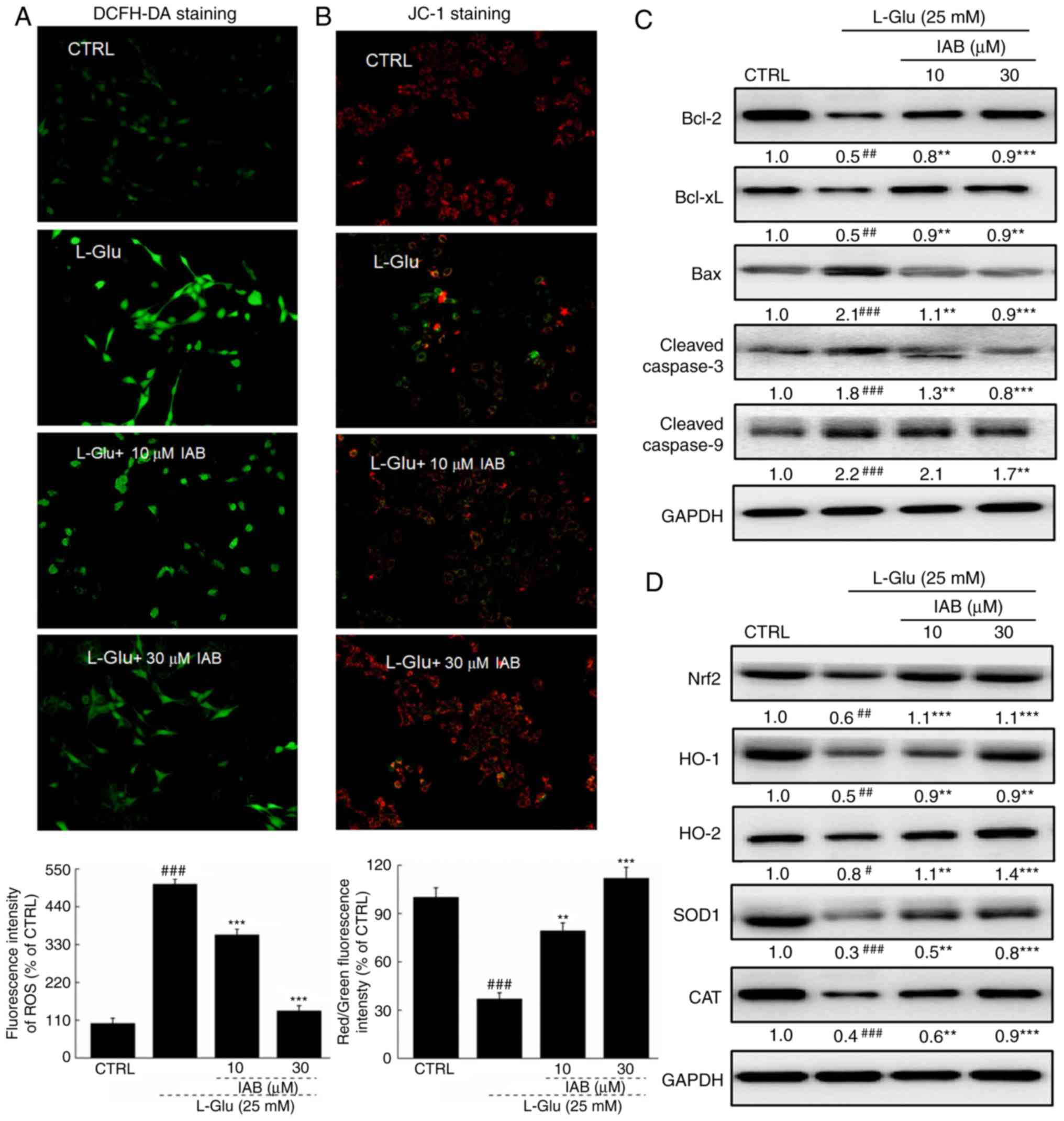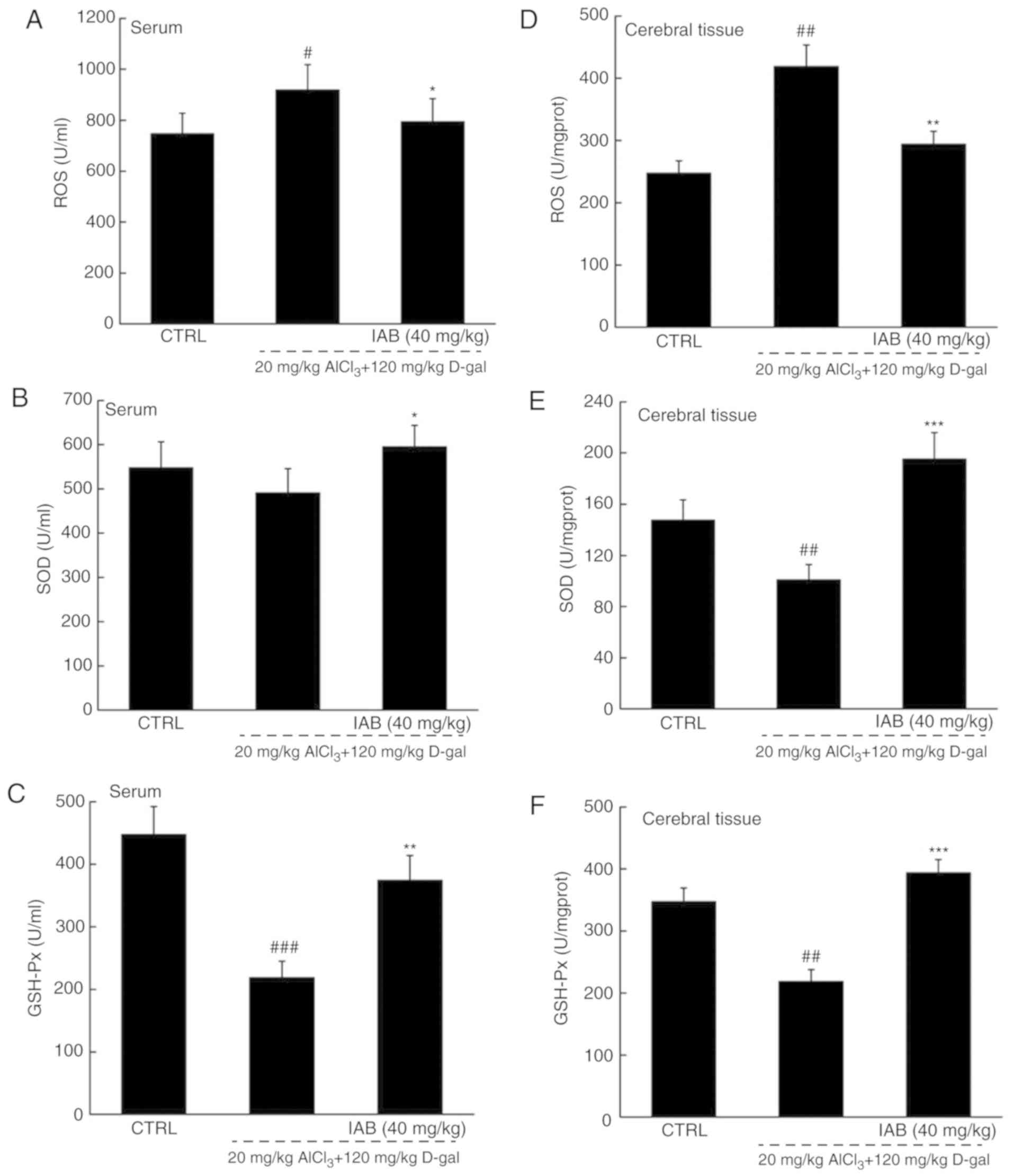|
1
|
Cheignon C, Tomas M, Bonnefont-Rousselot
D, Faller P, Hureau C and Collin F: Oxidative stress and the
amyloid beta peptide in Alzheimer's disease. Redox Biol.
14:450–464. 2018. View Article : Google Scholar
|
|
2
|
Coimbra JRM, Marques DFF, Baptista SJ,
Pereira CMF, Moreira PI, Dinis TCP, Santos AE and Salvador JAR:
Highlights in BACE1 Inhibitors for Alzheimer's disease treatment.
Front Chem. 6:1782018. View Article : Google Scholar : PubMed/NCBI
|
|
3
|
Rosello A, Warnes G and Meier UC: Cell
death pathways and autophagy in the central nervous system and its
involvement in neurodegeneration, immunity and central nervous
system infection: To die or not to die-that is the question. Clin
Exp Immunol. 168:52–57. 2012. View Article : Google Scholar : PubMed/NCBI
|
|
4
|
Angelova PR and Abramov AY: Role of
mitochondrial ROS in the brain: From physiology to
neurodegeneration. FEBS Lett. 592:692–702. 2018. View Article : Google Scholar : PubMed/NCBI
|
|
5
|
de Oliveira RB, Gravina FS, Lim R, Brichta
AM, Callister RJ and van Helden DF: Heterogeneous responses to
antioxidants in noradrenergic neurons of the Locus coeruleus
indicate differing susceptibility to free radical content. Oxid Med
Cell Longev. 2012:8202852012. View Article : Google Scholar : PubMed/NCBI
|
|
6
|
Daulatzai MA: Cerebral hypoperfusion and
glucose hypometabolism: Key pathophysiological modulators promote
neurodegeneration, cognitive impairment, and Alzheimer's disease. J
Neurosci Res. 95:943–972. 2017. View Article : Google Scholar
|
|
7
|
Nesi G, Sestito S, Digiacomo M and
Rapposelli S: Oxidative stress, mitochondrial abnormalities and
proteins deposition: Multitarget approaches in Alzheimer's disease.
Curr Top Med Chemy. 17:3062–3079. 2017.
|
|
8
|
Tyagi N, Ovechkin AV, Lominadze D, Moshal
KS and Tyagi SC: Mitochondrial mechanism of microvascular
endothelial cells apoptosis in hyperhomocysteinemia. J Cell
Biochem. 98:1150–1162. 2006. View Article : Google Scholar : PubMed/NCBI
|
|
9
|
Liu X, Wang J, Lu C, Zhu C, Qian B, Li Z,
Liu C, Shao J and Yan J: The role of lysosomes in BDE 47-mediated
activation of mitochondrial apoptotic pathway in HepG2 cells.
Chemosphere. 124:10–21. 2015. View Article : Google Scholar
|
|
10
|
Luo P, Fei F, Zhang L, Qu Y and Fei Z: The
role of glutamate receptors in traumatic brain injury: Implications
for postsynaptic density in pathophysiology. Brain Res Bull.
85:313–320. 2011. View Article : Google Scholar : PubMed/NCBI
|
|
11
|
Dinkova-Kostova AT and Abramov AY: The
emerging role of Nrf2 in mitochondrial function. Free Radic Biol
Med. 88:179–188. 2015. View Article : Google Scholar : PubMed/NCBI
|
|
12
|
Joshi G, Gan KA, Johnson DA and Johnson
JA: Increased Alzheimer's disease-like pathology in the APP/ PS1ΔE9
mouse model lacking Nrf2 through modulation of autophagy. Neurobiol
Aging. 36:664–679. 2015. View Article : Google Scholar
|
|
13
|
McDade E and Bateman RJ: Stop alzheimer's
before it starts. Nature. 547:153–155. 2017. View Article : Google Scholar : PubMed/NCBI
|
|
14
|
Querfurth HW and LaFerla FM: Alzheimer's
Disease. N Engl J Med. 362:329–344. 2010. View Article : Google Scholar : PubMed/NCBI
|
|
15
|
Jesky R and Hailong C: Are herbal
compounds the next frontier for alleviating learning and memory
impairments? An integrative look at memory, dementia and the
promising therapeutics of traditional Chinese medicines. Phytother
Res. 25:1105–1118. 2011. View Article : Google Scholar : PubMed/NCBI
|
|
16
|
Man SC, Chan KW, Lu JH, Durairajan SS, Liu
LF and Li M: Systematic review on the efficacy and safety of herbal
medicines for vascular dementia. Evid Based Complement Alternat
Med. 2012:4262152012. View Article : Google Scholar : PubMed/NCBI
|
|
17
|
Zhang Y, Wang J, Wang C, Li Z, Liu X,
Zhang J, Lu J and Wang D: Pharmacological basis for the use of
evodiamine in alzheimer's disease: Antioxidation and antiapoptosis.
Int J Mol Sci. 19:pii: E1527. 2018.
|
|
18
|
Hu S, Wang D, Zhang J, Du M, Cheng Y, Liu
Y, Zhang N, Wang D and Wu Y: Mitochondria related pathway is
essential for polysaccharides purified from Sparassis crispa
mediated neuro-protection against glutamate-induced toxicity in
differentiated PC12 cells. Int J Mol Sci. 17:pii: E133. 2016.
View Article : Google Scholar
|
|
19
|
An S, Lu W, Zhang Y, Yuan Q and Wang D:
Pharmacological basis for use of Armillaria mellea polysaccharides
in Alzheimer's disease: Antiapoptosis and antioxidation. Oxid Med
Cell Longev. 2017:41845622017. View Article : Google Scholar :
|
|
20
|
Du Q, Li L and Jerz G: Purification of
astilbin and isoastilbin in the extract of Smilax glabra rhizome by
high-speed counter-current chromatography. J Chromatogr A.
1077:98–101. 2005. View Article : Google Scholar : PubMed/NCBI
|
|
21
|
Zhou X, Xu Q, Li JX and Chen T: Structural
revision of two flavanonol glycosides from Smilax glabra. Planta
Med. 75:654–655. 2009. View Article : Google Scholar : PubMed/NCBI
|
|
22
|
Lu CL, Zhu W, Wang M, Xu XJ and Lu CJ:
Antioxidant and anti-inflammatory activities of phenolic-enriched
extracts of Smilax glabra. Evid Based Complement Alternat Med.
2014:9104382014. View Article : Google Scholar : PubMed/NCBI
|
|
23
|
Wang D, Li S, Chen J, Liu L and Zhu X: The
effects of astilbin on cognitive impairments in a transgenic mouse
model of Alzheimer's disease. Cell Mol Neurobiol. 37:695–706. 2017.
View Article : Google Scholar
|
|
24
|
Zhang X, Chen Y, Cai G, Li X and Wang D:
Carnosic acid induces apoptosis of hepatocellular carcinoma cells
via ROS-mediated mitochondrial pathway. Chem Biol Interact.
277:91–100. 2017. View Article : Google Scholar : PubMed/NCBI
|
|
25
|
Li Z, Chen X, Lu W, Zhang S, Guan X, Li Z
and Wang D: Anti-oxidative stress activity is essential for Amanita
caesarea mediated neuroprotection on glutamate-induced apoptotic
HT22 cells and an Alzheimer's disease mouse model. Int J Mol Sci.
18:pii: E1623. 2017. View Article : Google Scholar
|
|
26
|
Parikh A, Kathawala K, Li J, Chen C, Shan
Z, Cao X, Wang YJ, Garg S and Zhou XF: Self-nanomicellizing solid
dispersion of edaravone: Part II: In vivo assessment of efficacy
against behavior deficits and safety in Alzheimer's disease model.
Drug Des Devel Ther. 12:2111–2128. 2018. View Article : Google Scholar : PubMed/NCBI
|
|
27
|
Zhao JM, Li L, Chen L, Shi Y, Li YW, Shang
HX, Wu LY, Weng ZJ, Bao CH and Wu HG: Comparison of the analgesic
effects between electro-acupuncture and moxibustion with visceral
hypersensitivity rats in irritable bowel syndrome. World J
Gastroenterol. 23:2928–2939. 2017. View Article : Google Scholar : PubMed/NCBI
|
|
28
|
Chun KA: Beta-amyloid imaging in dementia.
Yeungnam Univ J Med. 35:1–6. 2018. View Article : Google Scholar
|
|
29
|
Yamini P, Ray RS and Chopra K: Vitamin
D3 attenuates cognitive deficits and neuroinflammatory
responses in ICV-STZ induced sporadic Alzheimer's disease.
Inflammopharmacology. 26:39–55. 2018. View Article : Google Scholar
|
|
30
|
Tönnies E and Trushina E: Oxidative
stress, synaptic dysfunction, and Alzheimer's disease. J Alzheimers
Dis. 57:1105–1121. 2017. View Article : Google Scholar
|
|
31
|
Koh CH, Whiteman M, Li QX, Halliwell B,
Jenner AM, Wong BS, Laughton KM, Wenk M, Masters CL, Beart PM, et
al: Chronic exposure to U18666A is associated with oxidative stress
in cultured murine cortical neurons. J Neurochem. 98:1278–1289.
2006. View Article : Google Scholar : PubMed/NCBI
|
|
32
|
Circu ML and Aw TY: Reactive oxygen
species, cellular redox systems, and apoptosis. Free Radic Biol
Med. 48:749–762. 2010. View Article : Google Scholar : PubMed/NCBI
|
|
33
|
Resseguie EA, Staversky RJ, Brookes PS and
O'Reilly MA: Hyperoxia activates ATM independent from mitochondrial
ROS and dysfunction. Redox Biol. 5:176–185. 2015. View Article : Google Scholar : PubMed/NCBI
|
|
34
|
Skulachev VP: Cytochrome c in the
apoptotic and antioxidant cascades. FEBS Lett. 423:275–280. 1998.
View Article : Google Scholar : PubMed/NCBI
|
|
35
|
Reubold TF and Eschenburg S: A molecular
view on signal transduction by the apoptosome. Cell Signal.
24:1420–1425. 2012. View Article : Google Scholar : PubMed/NCBI
|
|
36
|
Allan LA and Clarke PR: Apoptosis and
autophagy: Regulation of caspase-9 by phosphorylation. FEBS J.
276:6063–6073. 2009. View Article : Google Scholar : PubMed/NCBI
|
|
37
|
Espin R, Roca FJ, Candel S, Sepulcre MP,
González-Rosa JM, Alcaraz-Pérez F, Meseguer J, Cayuela ML, Mercader
N and Mulero V: TNF receptors regulate vascular homeostasis in
zebrafish through a caspase-8, caspase-2 and P53 apoptotic program
that bypasses caspase-3. Dis Model Mech. 6:383–396. 2013.
View Article : Google Scholar :
|
|
38
|
Gross A and Katz SG: Non-apoptotic
functions of BCL-2 family proteins. Cell Death Differ.
24:1348–1358. 2017. View Article : Google Scholar : PubMed/NCBI
|
|
39
|
Wang X, Wu J, Yu C, Tang Y, Liu J, Chen H,
Jin B, Mei Q, Cao S and Qin D: Lychee seed saponins improve
cognitive function and prevent neuronal injury via inhibiting
neuronal apoptosis in a rat model of Alzheimer's disease.
Nutrients. 9:pii: E105. 2017. View Article : Google Scholar
|
|
40
|
Tong Y, Bai L, Gong R, Chuan J, Duan X and
Zhu Y: Shikonin protects PC12 cells against beta-amyloid
peptide-induced cell injury through antioxidant and antiapoptotic
activities. Sci Rep. 8:262018. View Article : Google Scholar
|
|
41
|
Lai YC, Li CC, Sung TC, Chang CW, Lan YJ
and Chiang YW: The role of cardiolipin in promoting the membrane
pore-forming activity of BAX oligomers. Biochim Biophys Acta
Biomembr. 1861:268–280. 2019. View Article : Google Scholar
|
|
42
|
O'Connell MA and Hayes JD: The Keap1/Nrf2
pathway in health and disease: From the bench to the clinic.
Biochem Soc Trans. 43:687–689. 2015. View Article : Google Scholar : PubMed/NCBI
|
|
43
|
Chu H, Yu H, Ren D, Zhu K and Huang H:
Plumbagin exerts protective effects in nucleus pulposus cells by
attenuating hydrogen peroxide-induced oxidative stress,
inflammation and apoptosis through NF-κB and Nrf-2. Int J Mol Med.
37:1669–1676. 2016. View Article : Google Scholar : PubMed/NCBI
|
|
44
|
Zhu L, Liu Z, Feng Z, Hao J, Shen W, Li X,
Sun L, Sharman E, Wang Y, Wertz K, et al: Hydroxytyrosol protects
against oxidative damage by simultaneous activation of
mitochondrial biogenesis and phase II detoxifying enzyme systems in
retinal pigment epithelial cells. J Nutr Biochem. 21:1089–1098.
2010. View Article : Google Scholar : PubMed/NCBI
|
|
45
|
Khalaj L, Nejad SC, Mohammadi M, Zadeh SS,
Pour MH, Ahmadiani A, Khodagholi F, Ashabi G, Alamdary SZ and
Samami E: Gemfibrozil pretreatment proved protection against acute
restraint stress-induced changes in the male rats' hippocampus.
Brain Res. 1527:117–130. 2013. View Article : Google Scholar : PubMed/NCBI
|
|
46
|
Kaur SJ, McKeown SR and Rashid S: Mutant
SOD1 mediated pathogenesis of amyotrophic lateral sclerosis. Gene.
577:109–118. 2016. View Article : Google Scholar
|
|
47
|
Kansanen E, Kuosmanen SM, Leinonen H and
Levonen AL: The Keap1-Nrf2 pathway: Mechanisms of activation and
dysregulation in cancer. Redox Biol. 1:45–49. 2013. View Article : Google Scholar : PubMed/NCBI
|
|
48
|
Qu Z, Zhang J, Yang H, Huo L, Gao J, Chen
H and Gao W: Protective effect of tetrahydropalmatine against
d-galactose induced memory impairment in rat. Physiol Behav.
154:114–125. 2016. View Article : Google Scholar
|
|
49
|
Jiang T, Sun Q and Chen S: Oxidative
stress: A major pathogenesis and potential therapeutic target of
antioxidative agents in Parkinson's disease and Alzheimer's
disease. Prog Neurobiol. 147:1–19. 2016. View Article : Google Scholar : PubMed/NCBI
|
|
50
|
Xu T, Niu C, Zhang X and Dong M:
β-Ecdysterone protects SH-SY5Y cells against β-amyloid-induced
apoptosis via c-Jun N-terminal kinase- and Akt-associated
complementary pathways. Lab Invest. 98:489–499. 2018. View Article : Google Scholar : PubMed/NCBI
|
|
51
|
Kim DI, Lee KH, Gabr AA, Choi GE, Kim JS,
Ko SH and Han HJ: Aβ-Induced Drp1 phosphorylation through Akt
activation promotes excessive mitochondrial fission leading to
neuronal apoptosis. Biochim Biophys Acta. 1863:2820–2834. 2016.
View Article : Google Scholar : PubMed/NCBI
|
|
52
|
Leuner K, Schütt T, Kurz C, Eckert SH,
Schiller C, Occhipinti A, Mai S, Jendrach M, Eckert GP, Kruse SE,
et al: Mitochondrion-derived reactive oxygen species lead to
enhanced amyloid beta formation. Antioxid Redox Signal.
16:1421–1433. 2012. View Article : Google Scholar : PubMed/NCBI
|
|
53
|
Fujita K, Yamafuji M, Nakabeppu Y and Noda
M: Therapeutic approach to neurodegenerative diseases by medical
gases: Focusing on redox signaling and related antioxidant enzymes.
Oxid Med Cell Longev. 2012:3242562012. View Article : Google Scholar : PubMed/NCBI
|
|
54
|
Islam MT: Oxidative stress and
mitochondrial dysfunction-linked neurodegenerative disorders.
Neurol Res. 39:73–82. 2017. View Article : Google Scholar
|
|
55
|
Fei M, Jianghua W, Rujuan M, Wei Z and
Qian W: The relationship of plasma Aβ levels to dementia in aging
individuals with mild cognitive impairment. J Neurol Sci.
305:92–96. 2011. View Article : Google Scholar : PubMed/NCBI
|
|
56
|
Park SY and Ferreira A: The generation of
a 17 kDa neurotoxic fragment: An alternative mechanism by which tau
mediates beta-amyloid-induced neurodegeneration. J Neurosci.
25:5365–5375. 2005. View Article : Google Scholar : PubMed/NCBI
|
|
57
|
Reifert J, Hartung-Cranston D and
Feinstein SC: Amyloid beta-mediated cell death of cultured
hippocampal neurons reveals extensive Tau fragmentation without
increased full-length tau phosphorylation. J Biol Chem.
286:20797–20811. 2011. View Article : Google Scholar : PubMed/NCBI
|
|
58
|
Bartus RT: On neurodegenerative diseases,
models, and treatment strategies: Lessons learned and lessons
forgotten a generation following the cholinergic hypothesis. Exp
Neurol. 163:495–529. 2000. View Article : Google Scholar : PubMed/NCBI
|
|
59
|
Ferreira-Vieira TH, Guimaraes IM, Silva FR
and Ribeiro FM: Alzheimer's disease: Targeting the cholinergic
system. Curr Neuropharmacol. 14:101–115. 2016. View Article : Google Scholar : PubMed/NCBI
|
|
60
|
Deiana S, Platt B and Riedel G: The
cholinergic system and spatial learning. Behav Brain Res.
221:389–411. 2011. View Article : Google Scholar
|
|
61
|
Lushchekina S, Kots E, Novichkova D,
Petrov K and Masson P: Role of Acetylcholinesterase in β-amyloid
aggregation studied by accelerated molecular dynamics.
Bionanoscience. 7:396–402. 2017. View Article : Google Scholar
|
|
62
|
Nitta A, Itoh A, Hasegawa T and Nabeshima
T: beta-Amyloid protein-induced Alzheimer's disease animal model.
Neurosci Lett. 170:63–66. 1994. View Article : Google Scholar : PubMed/NCBI
|

















